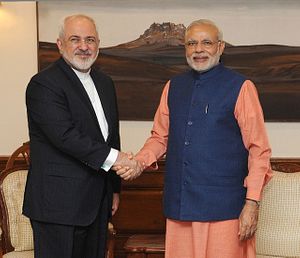Since 2014, buoyed by the economic pitch of Prime Minister Narendra Modi, India has been in the global economic spotlight. In 2016, however, at least some of the focus will shift to Iran, as it rejoins the global economy following the lifting of sanctions. What does this new Iran really mean for India? As much as it can benefit from a more open Iran, India will also face some more serious competition, from both Iran and its potential partners.
There is no doubt that India will benefit from cheaper commodity prices and an Iranian shopping spree. With Iran boosting its oil production and exports amid a global supply glut, major crude oil importers like India will benefit immensely from the cheaper oil. For India, cheaper oil helps it to reduce its import bill, reducing trade and current account deficits. The Indian government has already taken the opportunity to hike excise duties on fuels, which are expected to yield additional government revenue at a time of fiscal consolidation.
But Iran’s comeback means more than just cheaper oil and better fiscal position. Besides agro and allied products, which have been India’s biggest exports to Iran, exports of Indian pharmaceuticals, IT, commodities, and general goods are all expected to increase. The Indian government is moving swiftly to expand trade ties with Iran. During the second meeting of the Joint Working Group on Trade and Commerce in November 2015, Iran and India agreed “to open up a channel for exchange of information” to start preliminary consultations for a preferential trade agreement (PTA).
Indian companies are also expected to play a greater role in Iran’s infrastructure projects. In fact, Iran has asked India to invest $8 billion in infrastructure projects, particularly in connectivity plans. India has already signed a memorandum of understanding with Iran to develop the strategic Chabahar port and pledged to invest about $85 million. India is also keen to develop Iran’s railways, participating in the Chahbahar-Zahedan-Mashhad railway line as well as supplying rail tracks, rolling stock, signaling and other equipment.
Energy is another area where India is seeking for greater access. During the 18th session of the India-Iran Joint Commission in December 2015, External Affairs Minister Sushma Swaraj conveyed India’s interest in exploring Iranian oil and gas blocks and asked Iran to allow India to develop Farzad-B gas field, which was discovered by a consortium of Indian companies in 2008.
More Competition
Despite the much-hyped expectations of opportunities in post-sanctions Iran, India is likely to face more competition in engaging with Iran. During sanctions, India was one of the few countries that continued trade links with Iran. Food, pharmaceuticals and medical equipment were explicitly excluded under the sanctions, and Iran imported basmati rice, sugar, soymeal, corn and other products from India, whose exports to Iran almost doubled in the years since 2011. With the sanctions lifted, however, Iran now has more options for both its exports and its imports – all major exporting countries are keen to tap the Iranian market. China moved first when President Xi Jinping visited Iran last month to expand trade and strengthen ties. On February 15, a cargo train from China arrived in Tehran in an attempt to revive the ancient Silk Road. This will only buttress Iran’s geostrategic position.
Competing with others in the Iranian market is not the only concern. India now will have to compete with Iran itself for foreign investment. Less than two weeks after sanctions were lifted, Iranian President Hassan Rouhani signed megadeals worth billions during his state visit to Europe. Iran now expects to attract up to $50 billion in foreign investment and finance in the next fiscal year, which begins on March 20. The upsurge of global interest in the Iranian market is clearly evident. China and Europe are already racing to get a slice of the pie. A bilateral investment pact between Japan and Iran was signed early this month, while Joint Economic Committee meeting between Iran and South Korea will be held tomorrow with the expectation of signing more than 15 agreements. With Iran emerging as the next frontier for investment, India is no longer a sure thing to remain the world’s most favored investment destination when U.S. primary sanctions against Iran are lifted.
Iran’s reengagement with the world certainly promises great opportunities to India. However, India is not the sole beneficiary, and New Delhi will need to consider its strategy carefully.
Dr. Soyen Park is a South Korean national, currently living in New Delhi where she works as a researcher on the Indian economy.

































